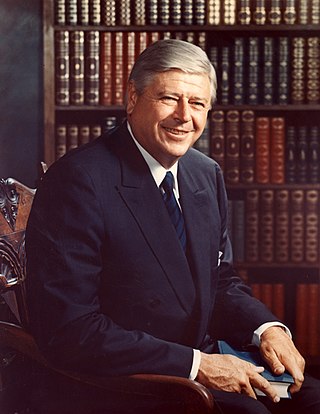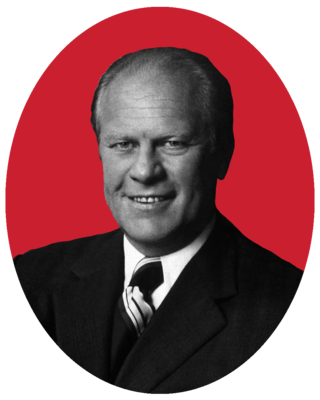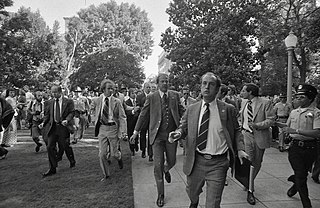Related Research Articles

Donald Henry Rumsfeld was an American politician, government official and businessman who served as Secretary of Defense from 1975 to 1977 under president Gerald Ford, and again from 2001 to 2006 under President George W. Bush. He was both the youngest and the oldest secretary of defense. Additionally, Rumsfeld was a three-term U.S. Congressman from Illinois (1963–1969), director of the Office of Economic Opportunity (1969–1970), counselor to the president (1969–1973), the U.S. Representative to NATO (1973–1974), and the White House Chief of Staff (1974–1975). Between his terms as secretary of defense, he served as the CEO and chairman of several companies.

James Earl Carter Jr. is an American retired politician who served as the 39th president of the United States from 1977 to 1981. A member of the Democratic Party, he served as the 76th governor of Georgia from 1971 to 1975, and as a Georgia state senator from 1963 to 1967.

The Watergate scandal was a major political scandal in the United States involving the administration of President Richard Nixon from 1972 to 1974 that led to Nixon's resignation. The scandal stemmed from the Nixon administration's persistent attempts to cover up its involvement in the June 17, 1972 burglary of the Democratic National Committee headquarters at the Washington, D.C., Watergate Office Building.

Elizabeth Anne Ford was the first lady of the United States from 1974 to 1977, as the wife of President Gerald Ford. As first lady, she was active in social policy and set a precedent as a politically active presidential spouse. Ford also served as the second lady of the United States from 1973 to 1974 when her husband was vice president.

The United States Bicentennial was a series of celebrations and observances during the mid-1970s that paid tribute to historical events leading up to the creation of the United States of America as an independent republic. It was a central event in the memory of the American Revolution. The Bicentennial culminated on Sunday, July 4, 1976, with the 200th anniversary of the adoption of the Declaration of Independence by the Founding Father delegates of the Second Continental Congress.

Most United States presidents have kept pets while in office, or pets have been part of their families. Only James K. Polk, Andrew Johnson, and Donald Trump did not have any presidential pets while in office. However, Johnson did take care of some mice he found in his bedroom.

Gerald Ford's tenure as the 38th president of the United States began on August 9, 1974, upon the resignation of Richard Nixon from office, and ended on January 20, 1977, a period of 895 days. Ford, a Republican from Michigan, had served as vice president since December 6, 1973, following Spiro Agnew's resignation from that office. Ford was the only person to serve as president without being elected to either the presidency or the vice presidency. His presidency ended following his defeat in the 1976 presidential election by Democrat Jimmy Carter.

Rogers Clark Ballard Morton was an American politician who served as the U.S. Secretary of the Interior and Secretary of Commerce during the administrations of presidents Richard Nixon and Gerald Ford, respectively. He also served as a member of the U.S. House of Representatives from Maryland.

The 1976 Republican National Convention was a United States political convention of the Republican Party that met from August 16 to August 19, 1976, to select the party's nominees for president and vice president. Held in Kemper Arena in Kansas City, Missouri, the convention nominated President Gerald Ford for a full term, but only after narrowly defeating a strong challenge from former California Governor Ronald Reagan. The convention also nominated Senator Bob Dole from Kansas for vice president, instead of Vice President Nelson Rockefeller, who did not seek nomination for a full term. The keynote address was delivered by Tennessee Senator Howard Baker. Other notable speakers included Minnesota Representative Al Quie, retired Lieutenant Colonel and former Vietnam prisoner of war Raymond Schrump, former Texas Governor John Connally, Providence, Rhode Island mayor Vincent Cianci and Michigan Senator Robert P. Griffin. It is the last national convention by either of the two major parties to feature a seriously contested nomination between candidates.

The Fall of Saigon, also known as the Liberation of Saigon or Liberation of the South by the Vietnamese government, and known as Black April by anti-communist overseas Vietnamese, was the capture of Saigon, the capital of South Vietnam, by the People's Army of Vietnam (PAVN) and the National Liberation Front of South Vietnam on 30 April 1975. The event marked the end of the Vietnam War and the collapse of the non-communist South Vietnamese regime as well as the start of a transition period from the formal reunification of Vietnam into the Socialist Republic of Vietnam under communist rule.

Jochen Richard Mass is a German former racing driver.
Chester Plummer was a taxi driver in the Washington, D.C. area of the United States who attempted to invade the White House.

Gerald Rudolph Ford Jr. was an American politician who served as the 38th president of the United States from 1974 to 1977. He previously served as the leader of the Republican Party in the House of Representatives from 1965 to 1973, when he was appointed the 40th vice president by President Richard Nixon, after the resignation of Spiro Agnew. Ford succeeded to the presidency when Nixon resigned in 1974, but was defeated for election to a full term in 1976. Ford is the only person to become U.S. president without winning an election for president or vice president.

On September 5, 1975, Lynette "Squeaky" Fromme, a member of the Manson Family cult, attempted to assassinate United States president Gerald Ford in Sacramento, California. She wanted to make a statement to people who refused to halt environmental pollution and its effects on air, trees, water, and animals (ATWA). Although Fromme stood a little more than an arm's length from Ford that Friday morning and pointed an M1911 pistol at him in the public grounds of the California State Capitol building, she had not chambered a round, the gun did not fire, and no one was injured.

The 2014 White House intrusion occurred on September 19, 2014, when Omar J. Gonzalez, an Iraq War veteran with post-traumatic stress disorder, jumped over the White House's fence and entered the building's front door, overpowered a security officer, was stopped by another who was off-duty, then later by multiple security officers, and arrested. He was found to have a small knife in his pocket, and stated that the "atmosphere was collapsing" and he needed to tell the president so that he could alert the public. President Barack Obama and his family were not home at the time of the incident. As a result of this incident and other security breaches at the White House, the then-director of the United States Secret Service, Julia Pierson, resigned from her position on October 1, 2014.

Proclamation 4311 was a presidential proclamation issued by president of the United States Gerald Ford on September 8, 1974, granting a full and unconditional pardon to Richard Nixon, his predecessor, for any crimes that he might have committed against the United States as president. In particular, the pardon covered Nixon's actions during the Watergate scandal. In a televised broadcast to the nation, Ford, who had succeeded to the presidency upon Nixon's resignation, explained that he felt the pardon was in the best interests of the country and that the Nixon family's situation was "a tragedy in which we all have played a part. It could go on and on and on, or someone must write the end to it. I have concluded that only I can do that, and if I can, I must."

The presidential transition of Jimmy Carter began when he won the 1976 United States presidential election, becoming the president-elect, and ended when Carter was inaugurated at noon EST on January 20, 1977.
References
- ↑ Chaplin, Gordon (2 October 1977). "The White House Cases". The Washington Post. Retrieved 4 November 2022.
- ↑ "WHITE HOUSE ORDERS REPORT ON INTRUDER". The New York Times. 16 December 1975. Retrieved 4 November 2022.
- ↑ "Young Man Again Caught Scaling White House Fence". Reading Eagle. August 16, 1976. p. 6. Retrieved August 7, 2011.
- ↑ Federation of American Scientists, White House Security Review Archived 2006-09-23 at the Wayback Machine
- ↑ Protection of the White House Complex in the Twentieth Century
- ↑ "White House fence stunt repeated: Intruder getting familiar". Calgary Herald. August 16, 1976. p. 8. Retrieved August 7, 2011.